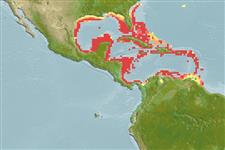Common names from other countries
Environment: milieu / climate zone / depth range / distribution range
Ecología
marino asociado a arrecife; no migratorio; rango de profundidad 1 - 100 m (Ref. 110583), usually 15 - 55 m (Ref. 110583). Tropical; 33°N - 9°S, 98°W - 57°W
Western Atlantic: southern Florida and the western Gulf of Mexico to the West Indies-Caribbean region and Venezuela.
Tamaño / Peso / Age
Maturity: Lm ? range ? - ? cm
Max length : 10.0 cm TL macho / no sexado; (Ref. 47838)
Espinas dorsales (total) : 13 - 14; Radios blandos dorsales (total) : 18 - 19; Espinas anales: 3; Radios blandos anales: 14 - 16. Upper half of body yellow-orange, shading into blackish basally in dorsal fin; lower half of body white; orange bands on head and a narrow orange bar on caudal peduncle (Ref. 13442).
Inhabit deep coral-rich reefs and drop-offs (Ref. 47838). Feed on small invertebrates. Often seen nibbling on the tube feet of sea urchins or the tentacles of tubeworms (Ref. 9710). Unlike some chaetodonts it does not pick parasites from the bodies of other fishes (Ref. 5521). Solitary, sometimes in pairs (Ref. 47838). Seek refuge when approached (Ref. 47838). Oviparous (Ref. 205). Form pairs during breeding (Ref. 205).
Life cycle and mating behavior
Maturities | Reproducción | Spawnings | Egg(s) | Fecundities | Larva
Form pairs during breeding (Ref. 205).
Allen, G.R., R. Steene and M. Allen, 1998. A guide to angelfishes and butterflyfishes. Odyssey Publishing/Tropical Reef Research. 250 p. (Ref. 47838)
IUCN Red List Status (Ref. 130435)
CITES (Ref. 128078)
Not Evaluated
Threat to humans
Harmless
Human uses
Pesquerías: comercial; Acuario: Comercial
Herramientas
Special reports
Download XML
Fuentes de Internet
Estimates based on models
Preferred temperature (Ref.
115969): 22.9 - 28, mean 26.5 (based on 234 cells).
Phylogenetic diversity index (Ref.
82804): PD
50 = 0.5002 [Uniqueness, from 0.5 = low to 2.0 = high].
Bayesian length-weight: a=0.02239 (0.01117 - 0.04486), b=3.02 (2.85 - 3.19), in cm Total Length, based on LWR estimates for this (Sub)family-body shape (Ref.
93245).
Nivel trófico (Ref.
69278): 3.4 ±0.2 se; based on diet studies.
Resiliencia (Ref.
120179): Alto, población duplicada en un tiempo mínimo inferior a 15 meses (Preliminary K or Fecundity.).
Fishing Vulnerability (Ref.
59153): Low vulnerability (10 of 100).
